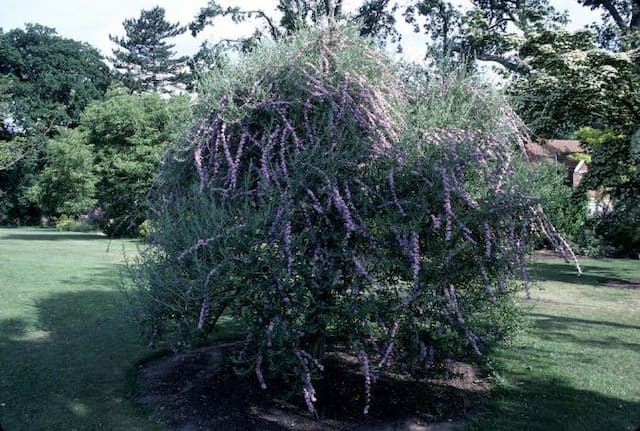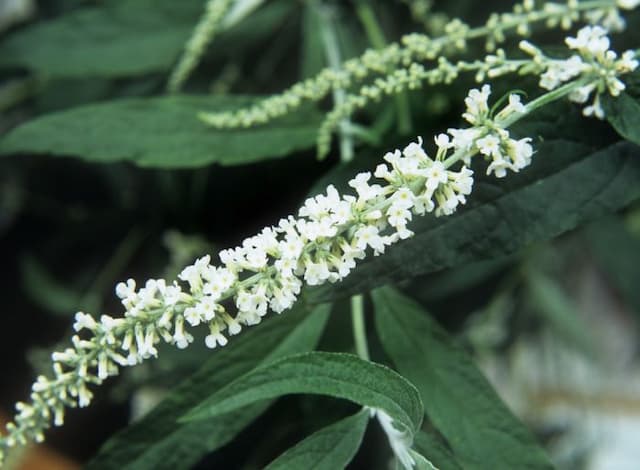Woolly Mullein Verbascum bombyciferum

ABOUT
Verbascum bombyciferum, commonly known as the Woolly Mullein, is a striking presence in the garden with a distinctive appearance. This plant is characterized by its broad, silver-gray leaves that are covered with a dense, woolly coating, giving them a soft, felt-like texture. The leaves are also quite large and form a rosette pattern at the base of the plant. As for the flowers, the Woolly Mullein produces long, erect spikes that are studded with bright yellow blossoms. These blooms are cup-shaped and arranged densely along the vertical flower stalks, creating a showy display that can add both height and color to a garden bed. The blooms are typically nestled among small, fuzzy leaves that cling to the flower spikes, enhancing the plant's overall woolly appearance. The Woolly Mullein's silvery foliage and sunny, yellow flowers provide a beautiful contrast against green landscapes and can serve as an eye-catching focal point within a planting scheme.
About this plant
 Names
NamesFamily
Scrophulariaceae
Synonyms
Arctic Summer, Woolly Mullein, Giant Silver Mullein, Olympic Mullein
Common names
Verbascum olympicum Boiss., Celsia bombycifera (Schrad.) Kuntze, Verbascum leianthum Boiss. & Kotschy
 Toxicity
ToxicityTo humans
Mullein, specifically Verbascum bombyciferum, is not considered toxic to humans. It does not contain any known poisonous substances that would cause serious harm if ingested. Therefore, there are no specific symptoms of poisoning associated with this plant when it comes to human ingestion. Keep in mind that despite its non-toxic nature, eating plants not specifically grown for consumption may carry risks of allergic reactions or digestive upset.
To pets
Mullein, specifically Verbascum bombyciferum, is generally not considered toxic to pets either. There are no known toxic compounds in mullein that would pose a risk to cats, dogs, or other domestic animals if they were to ingest parts of the plant. Just like with humans, ingestion is not associated with any specific symptoms of poisoning. However, as with any plant, eating large quantities or non-dietary foliage can lead to gastrointestinal discomfort or an allergic reaction in some pets.
 Characteristics
CharacteristicsLife cycle
Biennials
Foliage type
Deciduous
Color of leaves
Silver-gray
Flower color
Yellow
Height
6 feet (1.8 meters)
Spread
2 feet (0.6 meters)
Plant type
Herb
Hardiness zones
5
Native area
Turkey
Benefits
 General Benefits
General Benefits- Ornamental Value: Verbascum bombyciferum, commonly known as mullein, is prized for its dramatic appearance, with tall flower spikes and large, fuzzy leaves, adding aesthetic appeal to gardens.
- Drought Tolerance: Once established, mullein is highly drought-resistant, making it suitable for xeriscaping and arid garden designs.
- Wildlife Attraction: The flowers of mullein can attract various pollinators, including bees and butterflies, supporting biodiversity.
- Low Maintenance: Mullein generally requires minimal care once settled in a suitable location, making it an easy plant for gardeners of all skill levels.
- Erosion Control: With its deep root system, mullein can help stabilize soil and prevent erosion on slopes or in areas prone to soil degradation.
 Medical Properties
Medical PropertiesThis plant is not used for medical purposes.
 Air-purifying Qualities
Air-purifying QualitiesThis plant is not specifically known for air purifying qualities.
 Other Uses
Other Uses- Verbascum bombyciferum, commonly known as the Arctic Summer mullein, can be used in the textile industry where its soft, wooly leaves serve as a natural insulator in the creation of eco-friendly clothing and packing materials.
- The plant's tall and striking flower spikes are often harvested for use in dried floral arrangements, providing a unique aesthetic for interior decor.
- Due to its sizable rosette of leaves, the Arctic Summer mullein can be used as a natural dye, imparting a gentle greenish-yellow hue to fabrics.
- The stiff stems of Arctic Summer mullein have been historically used as makeshift torches when dipped in wax or fat, illuminating gatherings or pathways in gardens.
- The plant's leaves can serve as topical protection against intrusive insects in the garden, working as a natural insect deterrent when placed among vulnerable crops.
- Its silvery, dense foliage is sometimes utilized in landscaping as a contrasting texture in xeriscaping designs, which focus on water conservation.
- Seed fibers from Arctic Summer mullein have been experimented with as a potential source of natural, biodegradable fillers in the production of paper and cardboard.
- The leaves can be macerated and added to compost piles to accelerate decomposition due to their high mineral content, enhancing soil fertility.
- Artists have made use of Arctic Summer mullein's seed pods and stalks as organic sculptural materials due to their durability and interesting forms.
- Some cultures have used the downy leaves of the Arctic Summer mullein as a natural tinder for starting fires, especially when camping or during outdoor survival activities.
Interesting Facts
 Feng Shui
Feng ShuiThe Mullein is not used in Feng Shui practice.
 Zodiac Sign Compitability
Zodiac Sign CompitabilityThe Mullein is not used in astrology practice.
 Plant Symbolism
Plant Symbolism- Healing: Verbascum bombyciferum, commonly known as "Woolly Mullein," is traditionally used in herbal medicine, symbolizing physical and spiritual healing.
- Protection: In folklore, mullein has been used to ward off evil spirits and bad luck, representing the power of protection and safety.
- Courage: Mullein's ability to grow in harsh conditions and stand tall is often seen as a symbol of courage and resilience.
- Cleansing: Mullein has been used in herbal teas and smudging practices to purify the body and spaces, representing the clearing of negative energies.
- Love: In some traditions, mullein flowers have been used in love potions, symbolizing attraction and the enchantment of love.
 Water
WaterThe Mullein 'Arctic Summer', as Verbascum bombyciferum is commonly known, should be watered deeply but infrequently to mimic its natural drought-prone habitat. Ideally, the plant should receive about one inch of water per week. Adjustments should be made depending on rainfall, with less watering needed in wet periods and possibly more in dry spells. When watering, aim to soak the soil around the roots to encourage deep root growth, but allow the soil to dry out between waterings to prevent root rot. Overwatering can be detrimental to the plant's health, so moderation is key.
 Light
LightArctic Summer prefers full sun, thriving best in a location that provides direct sunlight for at least six hours each day. This exposure ensures the plant's robust growth and optimal flowering. Dappled light may be tolerated but could lead to reduced blooming and a leggy growth habit. For the healthiest plant, it is best to find the sunniest spot in your garden or landscape.
 Temperature
TemperatureArctic Summer is quite hardy and can withstand temperatures as low as -20 to -30 degrees Fahrenheit. The plant grows best in a typical garden climate, with temperature ranges from 60 to 80 degrees Fahrenheit. While this mullein can survive occasional dips and spikes in temperature, prolonged exposure to extremes beyond these thresholds can stress the plant.
 Pruning
PruningPruning Arctic Summer mullein is mainly done to remove spent flower spikes and encourage a second flush of blooms. Pruning can be done as soon as the flowers fade, cutting back the flower stalk to the base of the plant. Additionally, remove any damaged or diseased leaves to maintain plant health. Typically, pruning is done post-flowering, but occasional tidying may be necessary throughout the growing season.
 Cleaning
CleaningAs needed
 Soil
SoilMulllein, the common name for Verbascum bombyciferum, thrives best in a well-drained soil mix with low fertility. A mixture of sand, loam, and a small amount of compost is ideal, providing good drainage and mimicking its native habitat. The pH level should be neutral to slightly alkaline, around pH 6.5 to 8.0.
 Repotting
RepottingMullein should be repotted sparingly as it prefers not to be disturbed. Repotting is generally only necessary if the plant has outgrown its current container or if the soil needs refreshing. This may occur every 2-3 years or when the plant displays signs of stress due to insufficient space.
 Humidity & Misting
Humidity & MistingMullein tolerates a wide range of humidity levels and does not require high humidity to thrive. It is well-suited to the average humidity found in most homes and outdoor settings, making it a versatile plant choice for various environments.
 Suitable locations
Suitable locationsIndoor
Place Mullein in a sunny spot with well-drained soil indoors.
Outdoor
Plant Mullein in full sun with well-drained soil outside.
Hardiness zone
5-8 USDA
 Life cycle
Life cycleVerbascum bombyciferum, commonly known as the "Woolly Mullein," begins its life cycle as a seed which upon germination, generally in spring or early summer, produces a rosette of large, woolly, silver-gray leaves. These basal leaves can persist through the first growing season, supporting photosynthesis and growth while the plant remains in this vegetative state. In the second year, the plant bolts, sending up a tall flowering stalk that can reach up to 6 feet in height, where yellow flowers form densely along the spike. These flowers typically bloom in mid-to-late summer and are pollinated by insects, especially bees. After pollination, the flowers produce small capsules containing numerous seeds. Once the seeds are dispersed by wind or animals, the parent plant completes its biennial life cycle, dying after seed maturation and dispersal.
 Propogation
PropogationPropogation time
Spring-Early Summer
Propogation: The most popular method of propagating Verbascum bombyciferum, commonly known as the Woolly Mullein, is through seed. The best time for sowing is in late winter to early spring. Seeds can be sprinkled on the surface of a well-draining seed starting mix, as they need light to germinate. Covering the seeds with a light dusting of soil can prevent them from being too exposed. Watering should be done with care to avoid burying the seeds deeper into the soil. The tray or container with the seeds should be kept in a warm, brightly lit area but out of direct sunlight to facilitate germination, which usually occurs within two to three weeks. Once seedlings are large enough to handle and the danger of frost has passed, they can be transplanted outdoors at distances of about 18 inches (approximately 45 centimeters) apart to accommodate their growth.



![Butterfly bush [Florence]](/_next/image?url=https%3A%2F%2Fplants-admin.emdemapps.com%2Fimages%2Fplants%2F%2Fimages%2F604b5f52d7bb1.png&w=640&q=75)
![Butterfly bush [Marbled White]](/_next/image?url=https%3A%2F%2Fplants-admin.emdemapps.com%2Fimages%2Fplants%2F%2Fimages%2F604b63353832a.png&w=640&q=75)
![Butterfly bush [Nanho Blue]](/_next/image?url=https%3A%2F%2Fplants-admin.emdemapps.com%2Fimages%2Fplants%2F%2Fimages%2F604b55d0a6d2d.png&w=640&q=75)



